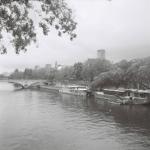|
Omnium Photo Photo-Mixte |
Manufactured or assembled in France from (Circa) 1932 to (After) 1932.
Index of rarity in France: Rare (among non-specialized garage sales)
Inventory number: 3810
See the complete technical specifications
Chronology of cameras Omnium Photo
Cet appareil est également vendu par Manufrance, sous le nom générique de Luminor. La fabrication par Natali, Collo et cie est indubitable.

Natali, Collo & Company was the name of a subcontracting manufacturer, not a commercial brand of cameras. All the production was sold under more well-known brands like Manufrance, Plavic, etc. These were distributors or players in the photography market who aimed to add affordable cameras to their catalog.
The cameras manufactured by Natali and Collo were of the Box or Detective type, as the materials used were not suitable for other forms. The wood used was lightweight and not very durable. The covering was limited to decorative paper glued to the wood, which over time tended to wrinkle. Some unusual features for the time are worth noting, such as imitation reptile skin in blue color.
The manufacturing quality was low in order to produce budget cameras. This is the primary characteristic of Natali and Collo cameras. Certain technical characteristics were consistent across the manufacturer's cameras. The shape of the shutter speed selector (P/I) resembled a racket; this design was found on several models. The film advance key was simple, often a bar passing through the axis of the winding spool. The locking mechanism for the back door of detective cameras was circular with a circular notch that allowed it to lock onto a simple nail. On other models, a metal piece with a small hole was positioned over a nail head. The shutter release button was sometimes absent and was simply the end of a rod.
While these features were not universal, these unique characteristics serve as a good basis for identifying cameras from Natali, Collo & Co.
Interesting links or bibliography :
Add a link or element of bibliography, a picture taken with this camera, a picture of box or an ads about this camera
Your photos taken with the same camera:
Cameras from Ebay France (Omnium Photo) (Uploaded each 3 hours)








